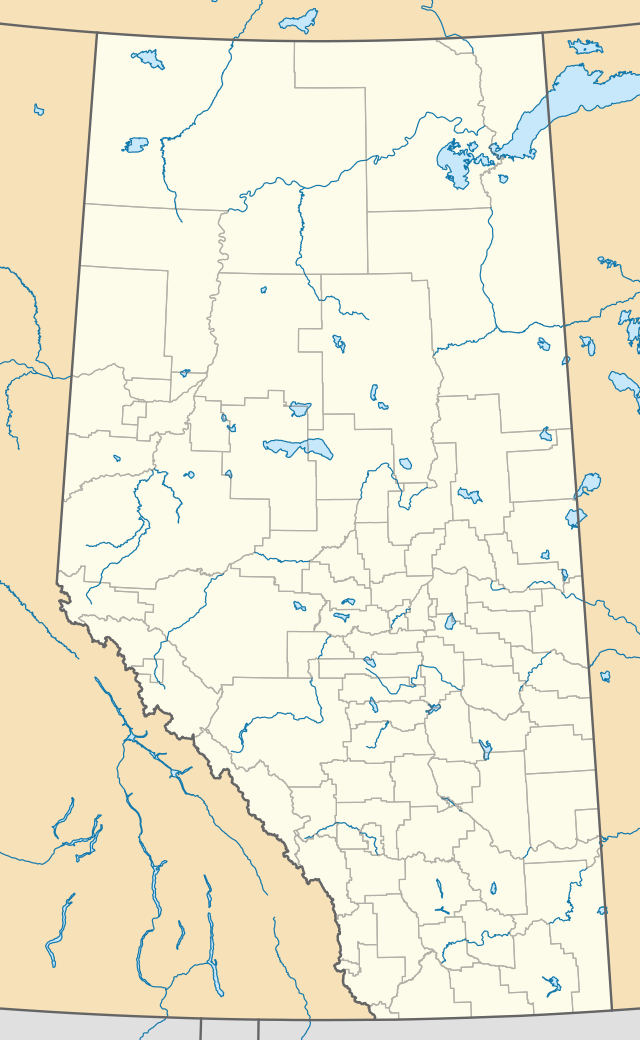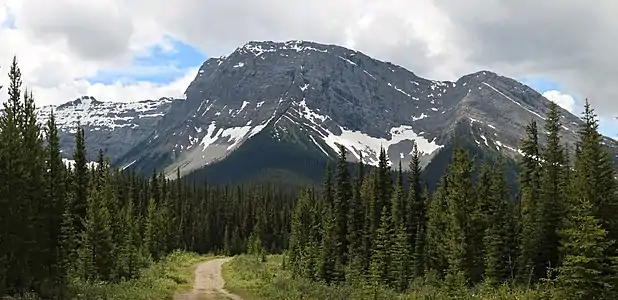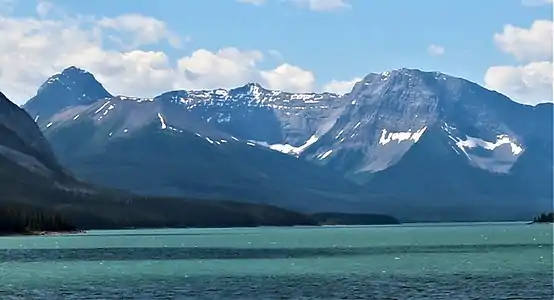Mount Shark
Mount Shark is a 2,786-metre (9,140-foot) mountain summit located in the Spray Valley of Kananaskis Country at the northern tip of the Spray Mountains range. It is situated on the southern boundary of Banff National Park in the Canadian Rockies of Alberta, Canada. Mount Shark in not visible from any road in Banff Park, however, it can be seen from Alberta Highway 742, also known as the Smith-Dorrien/Spray Trail. Mount Shark's nearest higher peak is Mount Smuts, 3.0 km (1.9 mi) to the southeast.[1]
| Mount Shark | |
|---|---|
 Mount Shark, northeast aspect | |
| Highest point | |
| Elevation | 2,786 m (9,140 ft) [1] |
| Prominence | 134 m (440 ft) [1] |
| Parent peak | Mount Smuts (2938 m)[1] |
| Listing | Mountains of Alberta |
| Coordinates | 50°49′41″N 115°24′36″W [2] |
| Geography | |
 Mount Shark Location of Mount Shark in Alberta  Mount Shark Mount Shark (Canada) | |
| Location | Alberta, Canada |
| Parent range | Spray Mountains Canadian Rockies |
| Topo map | NTS 82J/14[2] |
| Geology | |
| Age of rock | Cambrian |
| Type of rock | Sedimentary rock |
| Climbing | |
| Easiest route | Scramble[3] |
Like so many of the mountains in Kananaskis Country, Mount Shark received its name from the persons and ships involved in the 1916 Battle of Jutland, the only major sea battle of the First World War.[4]
History
Mount Shark was named in 1917 for HMS Shark, a British destroyer that was sunk by a torpedo launched by the German torpedo boat SMS S54 during the Battle of Jutland in World War I.[5][6] The mountain's name was officially adopted in 1922 by the Geographical Names Board of Canada.[2]
Geology
Mount Shark is composed of sedimentary rock laid down during the Precambrian to Jurassic periods.[7] Formed in shallow seas, this sedimentary rock was pushed east and over the top of younger rock during the Laramide orogeny.[8]
Climate
Based on the Köppen climate classification, Mount Shark is located in a subarctic climate with cold, snowy winters, and mild summers.[9] Temperatures can drop below −20 °C (−4 °F) with wind chill factors below −30 °C (−22 °F). Precipitation runoff from the mountain drains west into Spray Lakes Reservoir.
References
- "Mount Shark". Bivouac.com. Retrieved 2018-12-27.
- "Mount Shark". Geographical Names Data Base. Natural Resources Canada. Retrieved 2018-12-28.
- Alan Kane (1999). "Mount Shark". Scrambles in the Canadian Rockies. Rocky Mountain Books. p. 125. ISBN 0-921102-67-4.
- Battle of Jutland Alberta Historic Places
- Place-names of Alberta. Ottawa: Geographic Board of Canada. 1928. p. 115.
- "Mount Shark". PeakFinder.com. Retrieved 2019-10-08.
- Belyea, Helen R. (1960). The Story of the Mountains in Banff National Park (PDF). parkscanadahistory.com (Report). Ottawa: Geological Survey of Canada. Archived (PDF) from the original on 2015-10-02. Retrieved 2019-09-13.
- Gadd, Ben (2008). Geology of the Rocky Mountains and Columbias.
- Peel, M. C.; Finlayson, B. L.; McMahon, T. A. (2007). "Updated world map of the Köppen−Geiger climate classification". Hydrol. Earth Syst. Sci. 11: 1633–1644. ISSN 1027-5606.
Gallery
 Mount Shark
Mount Shark Mt. Smuts (left) and Mt. Shark (right) seen from Spray Lakes
Mt. Smuts (left) and Mt. Shark (right) seen from Spray Lakes
External links
- Mount Shark weather: Mountain Forecast
- Climbing photos by Bob Spirko: Mount Shark